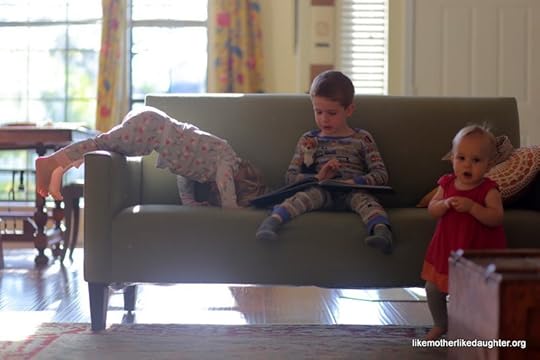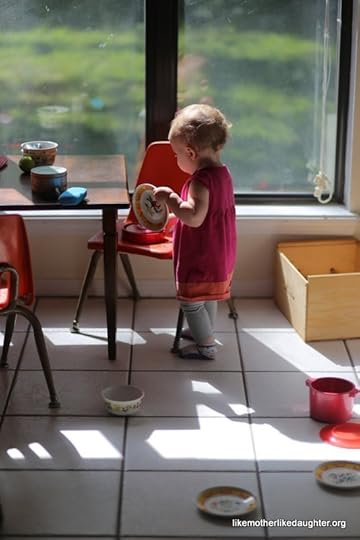Leila Marie Lawler's Blog, page 52
April 30, 2016
{bits & pieces}
Recently, we celebrated the first birthday of our dear little boy.


Which means that yes, it’s one year ago that Auntie Leila became an amateur midwife and a little less than a year since I recounted Peabodee’s dramatic entrance. In case you’re in a mood for a birth story.
I was talking with some friends about the paradox of a first birthday: on the one hand, we as the moms want to do well for our precious little ones and we sense the opportunity to start off a tradition; on the other hand, the kid is one, and therefore doesn’t care much and certainly won’t remember anything. It’s a funny place to be.

Despite my one-year-old being a very picky eater, I did land upon a few featured items that I thought he’d really enjoy on his big day. He loves cheese (especially cream cheese), he’s recently become a fan of graham crackers… His birthday is always going to be in the spring… So a springy carrot cake seems like a great tradition to start, right? What could be more perfect than this Carrot Graham Layer Cake from smitten kitchen*, which will – of course – be accompanied by a cream cheese frosting?!
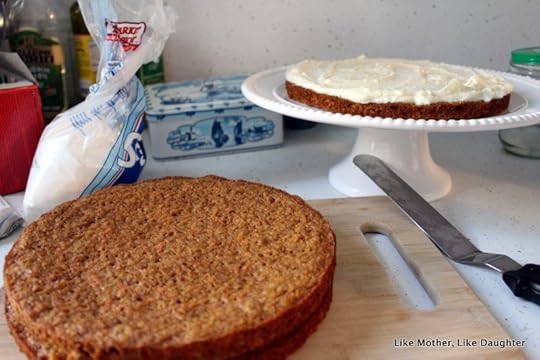
I thought that this was surely the jackpot. I had struck gold and would never again have to wonder what do make him for his birthday. He’d grow up loving this and always looking forward to it as his special cake that only comes around once a year… You’re welcome, future Deirdre – one less decision to make on an annual basis!
Except he didn’t finish his piece. Finnabee didn’t even finish her piece. Every following day since then when I’ve tried to tempt him with leftovers, he has flatly refused. And, to be honest, the Artist and I haven’t totally loved the cake, either.

*I wonder if the fault is mine for a slight recipe change: I didn’t have enough cream cheese for the proportions of the recipe, so I substituted ricotta cheese (about 1/2 cup, I’d say). When first mixed, the frosting tasted delicious. The first few bites of each slice of cake tasted delicious. But by the end of each piece there was something… dull? cloying? I wonder if we were missing an essential bit of zing from that extra cream cheese. (I also used coconut oil instead of butter, and wonder if that might be an explanation for why my layers seem flatter than Deb’s look.)
I haven’t completely given up, however. Maybe another time around I’ll try my mom’s carrot cake recipe, which is more carrot-y tasting, anyway.
This week’s links — again, a collection of miscellany this time around:
The feast of the Ascension is this coming Thursday. Does it matter that it’s Thursday? Can it just be another day? Douglas Farrow in First Things Magazine makes the case.
Mark Regnerus is a professor who has been vilified for standing by his findings on how children of same-sex couples fare. Time has only strengthened his position, however. Media Gush over New Study, only to Find Same-Sex Parents More Irritated with Their Children.
Auntie Leila says, “interesting — one of several stories recently that to me, just show that discoveries come from an interested person who pursues interesting thoughts, not from any particular sort of technical education.” Copper Pajamas: An 18-Year-Old School Girl Beats Scientists to A MRSA Remedy
This really needs no introduction: Midwife Rides Inflatable Swan trough Houston Floods to Deliver Baby
Christopher Mueller is directing all the English World Youth Day liturgies. Since music vitally affects the spirit of any particular liturgy, this is great news. Let’s help Mr. Mueller get his whole family (who sing chant and polyphony together) to Poland for this event! You can hear some of the music in the video at the top of this kickstarter page, and send a few dollars his way if you can (they are very close to their goal!). Who are the poor today? Many of them are those starving for beauty and true worship!
From the Archives:
Remember Nora’s Baptism last year? And why we care about getting the Baptism in without much delay.
Ask Auntie Leila: How to Talk to Children About Scary News
{bits & pieces} with a little Savory Pie How-To
~We’d like to be clear that, when we direct you to a site via one of our links, we’re not necessarily endorsing the whole site, but rather just referring you to the individual post in question (unless we state otherwise).~
Follow us on Twitter.
Like us on Facebook.
Auntie Leila’s Pinterest.
Rosie’s Pinterest.
Sukie’s Pinterest.
Deirdre’s Pinterest.
Habou’s Pinterest.
Bridget’s Pinterest.
Habou’s Blog: Corner Art Studio.
Auntie Leila’s Ravelry.
Auntie Leila’s Instagram.
Rosie’s Instagram.
Sukie’s Instagram.
Bridget’s Instagram.
The post {bits & pieces} appeared first on Like Mother Like Daughter.
April 28, 2016
{pretty, happy, funny, real} Did I mention we’re moving?
~ {pretty, happy, funny, real} ~
Capturing the context of contentment in everyday life ~
Every Thursday, here at Like Mother, Like Daughter!
I imagine you gathered, from the whole selling-the-house business.
We’re beginning to wrap things up here in Oklahoma (just had our last first tornado watch of the season. Ah, the nostalgia is setting in already…), and have orders to our next station — North Carolina!
That’s right, we’re heading back to the East Coast this summer, and are looking forward to living near the ocean again, and within (long, but reasonable) driving distance of family for the first time since before we had kids.
Our house has been on the market for about two weeks now, and we’ve had enough showings to keep us on our toes, but not quite enough for our house to just be clean all the time. Is that a thing? Clean all the time? I suspect it isn’t.
In fact, we continue to approach maximum mess-ability over here, since Eleanor is fully mobile (and quite the explorer), Molly has finally learned how to consistently open doors on her own, and as helpful as Pippo can be, there’s only so much spontaneous tidying a 5-year-old boy can be expected to be responsible for.
At least the two older ones can actually execute a pretty decent Blitz when they put their minds to it. We have done our best to associate house showings with ice cream and other fun to help in the motivation department.
Still, between the actual blitzing and vacuuming out the door and the knowing that at any moment we could get an hour’s notice to have the house ready, this all consumes more energy, mental and otherwise, than I hoped I could get away with it consuming. (A friend was telling me about having her home on the market, and realtors appearing at her door at no notice with clients, or calling from five minutes away. And she has more children than I do! I think I would go crazy.)
My consolation is that several times a week, we come home to an absolutely spotless house. I walk in and think, “This is a great house! I would totally buy this house!”
[image error] Loading InLinkz ...
The post {pretty, happy, funny, real} Did I mention we’re moving? appeared first on Like Mother Like Daughter.
April 25, 2016
Read This, Not That ~ A Good Spiritual Reading List!
Do you know this “eat this, not that” series of books? The idea is to help you make good choices in food and drink to avoid hidden calories that will tank your health. Well, Rosie had the thought that we could do something similar with books for the Library Project*.

Today I thought I’d look at spiritual reading, since so many of our readers do ask me for suggestions. Sometimes I’m at a conference with all the booksellers or even just walking by the table at the back of the church, and I just feel like fainting at the sheer quantity of unnecessary and clearly unhelpful stacks of spiritual reading. Sadly, so much of publishing has become putting out new material, whether it’s worthy or not.
Usually I simply pay no attention. It’s all a matter of trust, and why would I trust just any old book to be my spiritual reading? After all, this is my soul we are talking about! But a while ago Leila Miller (of Little Catholic Bubble) posted on Facebook about a hugely popular (and hugely promoted) book by Matthew Kelly called Rediscovering Catholicism. She took the book to task for a serious theological defect, found in his prologue, in the form of a sort of parable that leaves the reader with the mistaken idea that Jesus did not willingly die, but was unwillingly sacrificed by the Father.
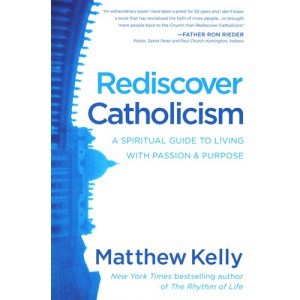
I agree with Leila Miller. I would not read this book on that basis alone and neither should you. Her post made me start thinking of what you should read instead.
Read tried-and-true books to discover what the Church teaches. It’s just all too easy for a zealous author to allow error to creep into his work if he’s not steeped in authentic and tested theology (and philosophy for that matter — we have an interesting discussion going on in the comments of this post about our Book Club’s reading of Ratzinger’s Spirit of the Liturgy; did you know that the admirable Dietrich Bonhoeffer was unable to prevent a Kantian modernism to take hold of his theology? Imitate his courage, perhaps, but not his thought!).
If you are looking for inspiration, be sure to read books that are either by saints or clearly base what they are saying on the words of saints and Scripture and the Church Fathers! (In our book, The Little Oratory, we take great pains to show you that what we write about is traditional and grounded in Church teaching.)
So, here is a short list of my favorites — books that are my real bosom friends — in foundational spiritual reading. As always, if you buy from our Amazon links, we get a little cash. Thanks!
Saint Pope John Paul II had his own project to help you rediscover (or discover) Catholicism, and that seems like a better bet, hmmm? The Catechism of the Catholic Church sounds like just another dry tome that wouldn’t interest you, but on the contrary, you will love it. You can certainly look up any question that you are wondering about (e.g. “What does the Church teach about stealing?” or “What are Sacraments?”), but I really suggest simply starting at the beginning. Until you do, you just can’t imagine how beautifully this book presents Salvation History, entwining it with what Reason can discover about man and his journey to God — and God’s work in saving us. The section on prayer is a masterpiece. And everything in between is a masterpiece. Read this instead of that other one! (I’ve linked to the paperback edition because it’s the only one I’m sure contains the footnotes and complete text. I think you would be wiser to invest in a hardback version, but mine is so old that it no longer corresponds to what I see on Amazon, and what I see is confusing. This one seems right… If you can buy it in person, that would be great — you want to be sure you have all the references!)
The heart of Catholicism is the Mass. Of course, read Romano Guardini’s The Spirit of the Liturgy (and read along with us!). And Ratzinger‘s as well (ditto!). I highly recommend Scott Hahn’s The Lamb’s Supper for an extended Biblical treatment of the Mass.
Would you like to pray, but just can’t? Maybe you just don’t get what prayer is? Difficulties in Mental Prayer by Dom Eugene Boylan will help. I’ve read it many, many times over. It sits by my bed. It isn’t just about prayer. Very gently, Boylan helps you prepare your soul to pray, and then shows you what prayer is.
This Tremendous Lover. Is Jesus a feeling? This book, also by Dom Eugene Boylan, helps you discover where you find the real Jesus. It gets you out of your head, by which I mean feelings!
The Soul of the Apostolate, by Jean-Baptiste Chautard. This book helped me discover the interior life. We know we must be charitable — “do apostolate” or “ministry” (although I don’t like that word, because ministers are ordained, but we all have to evangelize) — go out and “be Christ” to others. But how? What is the key? Without the interior life, we are mere activists, and more, what we do ends up being just for show or to make us feel good. We need the interior life.
Of course, The Interior Castle is the classic on this topic. St. Teresa of Avila is a wonderful guide.
Introduction to the Devout Life, by Francis de Sales. How to live as a Christian in the world!
The Story of a Soul, by Thérèse de Lisieux. Did you know that “The Little Flower” — as she is called — is a Doctor of the Church? The deceptive simplicity of her spirituality contains the key to holiness.
Perhaps this book can help us understand the previous two, or serve as an introduction: Searching for and Maintaining Peace, by Father Jacques Philippe. My thought is that this tiny, unassuming book is the real “mom’s book of spiritual help” we are looking for. With great affection and gentleness, Fr. Philippe helps us be reconciled with our defects — without which we would be incapable of receiving God’s grace!
Or, if you just don’t get St. Thérèse (but think there’s something about her you should get — and there is!), try this: I Believe in Love, by Fr. Jean C. J. d’Elbée. Sappy title, strong content. This book is a series of meditations, so it can be a good “self-led” retreat for you if you want to do something like that.
Saint Joseph, Shadow of the Father, by Andrew Doze. I recommend this deep meditation if you wonder about God the Father and your devotion (or lack thereof) to Him. Especially recommended for you if you have a father-wound, a sadness that’s the result of a lack of relationship with your father.
I could go on and on, and probably will revisit this list. If you are ever at a book sale and find this gem, which is out of print, snatch it up: The Well of Life, by Georges Chevrot. Not only is this an amazing book for spiritual reading, but it will pattern you for reading Scripture in a deeper way: Can you imagine, a whole book on the one meeting of Our Lord with the Woman at the Well? (Joh 4: 1-42) Beautiful.
*What is the Like Mother, Like Daughter Library Project?
The post Read This, Not That ~ A Good Spiritual Reading List! appeared first on Like Mother Like Daughter.
April 22, 2016
Apostasy or worship? The Spirit of the Liturgy: A Book Club

{Book Club: The Spirit of the Liturgy}
I hope you will read along in this book club (or just read my posts, that’s okay): Joseph Ratzinger’s The Spirit of the Liturgy.
(When you buy something via our Amazon affiliate link, a little cash rolls our way… just a little. Thanks!)
I’ll post on Fridays, although for this longer book, perhaps not every Friday. I’ll give you your homework, I’ll talk about what we read, we’ll discuss in the comments. Even if you read later, the comments will still be open.
Last week: Introduction
Homework: Read Chapter Two of Part I.
Know that Chapter One will make a lot more sense to you if you have read this chapter of Guardini, or at least this post.
Further hint: if a chapter bogs down for you, try reading the end of it and then going back. Usually our dear Pope Benedict wraps things up.
And don’t be fooled by his style. Very often he presents something someone says as if he is saying it himself, but he’s not. If you are starting to get uneasy (“Wait, does he think THAT??”), just hang in there and things will generally clear up.
Since there are many, many more directions our thoughts can go in, do feel free to bring up other interesting topics from the reading in the comments.
Ratzinger starts with his mentor Guardini’s point that liturgy is a kind of play (again, see the discussion here to understand what this means as a philosophical point). But (p. 15): “The analogy still lacks something, something essential…. a new approach, starting from specific biblical texts.”
He then speaks of Moses’ negotiation with Pharoah regarding the freedom to worship. Sixteen years after this is written, I feel that we, dealing with our secular society, can find a prophetic quality to this discussion!
To obey God’s command, Moses insists to Pharoah that “they must go out in order to worship.” (p. 15) “The manner in which God is to be worshipped is not a question of political feasibility.” Not, says Ratzinger, for the sake of the land in itself… but because “it is the place where God reigns.” (p. 17). At the bottom of that page he says something important for this study: “Israel learns how to worship God in the way he himself desires.”
This criterion — God’s own desires — is of course the only escape from preference!
Here God solidifies his relationship with His people and confirms His intention with His covenant (Ex 24)… to include “life according to the will of God… ultimately it is the very life of man… that is the true worship of God, but life only becomes real life when it receives its form from looking toward God. Cult exists in order to communicate this vision.” [my emphasis]
(By the way, the word cult here has a specific meaning: how one worships, so you can see how it got the general, popular meaning).
Here (on p. 18) begins a very important discourse on the relationship between instructions on worship, the law, and morality — that is to say, the way of life.
“In the ordering of the covenant on Sinai, the three aspects of worship, law, and ethics are inseparably interwoven.” Without this recognition of God, “there is a belittling of man.” (p. 19). “Where that right of God totally disappears, the order of law among men is dissolved.”
Sinai, the place God wanted the people to go, gives “the interior land” — and if it’s lost, the people will be in their own land but as if still in exile, in Egypt.
(p. 20) “Thus we can see what the foundation of existence in the Promised Land must be, the necessary condition for life in community and freedom… steadfast adherence to the law of God, which orders human affairs rightly… by organizing them as realities that come from God and are meant to return to God…. the ordering of the whole of human life…”
Put aside God in the name of “realism” and of “living life” and quickly fall away from reality and life itself — and go back into exile! The right relationship with God orders everything else, and to pretend otherwise is to take a step away from existence — from “the right kind of human existence in the world.”
Every society, even an atheistic one, has a “cult” — an order of worship. Rituals arise even if they are not chosen. The question is whether they are based in reality or are “only an illusion and strive in vain, by bombastic trumpeting, to conceal their nothingness.” (p. 21)
Man cannot “make” worship.
The whole thrust of this chapter is against what modern man takes as an assumption, that worship, if it’s necessary at all, is (as we would put it), a human construct. On the contrary. God has let us know how he would be worshiped, giving us our direction.
This truth we find when we read the Old Testament. And Ratzinger finishes this reflection with a surprising look at the infamous worshipping of the Golden Calf, emphasizing not the idolatry, pure and simple, but the “self-affirmation” of it, the do “what you please.”
“The apostasy is more subtle [than serving false gods]… They want to glorify the God who led Israel out of Egypt and believe that they may very properly represent his mysterious power in the image of a bull calf… presumably even the ritual is in complete conformity to the rubrics.
And yet it is a falling away from the worship of God to idolatry. This apostasy… has two causes. First… they want to bring [God] down into their own world… Man is using God… [Second], the worship of the golden calf is a self-generated cult.
Worship becomes a feast the community gives itself, a festival of self-affirmation… it becomes a circle closed in on itself: eating, drinking, and making merry.” [my emphasis]
These last paragraphs, on pages 22 and 23, amount to a sort of examination of conscience for worship, for liturgy. Is this what we do? Because if so, it would be terrible.
“The narrative of the golden calf is a warning about any kind of self-initiated and self-seeking worship…. a nice little alternative world, manufactured from one’s own resources. The liturgy really does become pointless, just fooling around.”
Or worse, “an apostasy in sacral disguise.”
Do share with us what you think of this chapter! I look forward to your comments!
Click here to see our previous discussion of Romano Guardini’s The Spirit of the Liturgy, which you can read free, online. You can also purchase it here, although be warned, this edition does not have the footnotes, which stinks
 .
.The post Apostasy or worship? The Spirit of the Liturgy: A Book Club appeared first on Like Mother Like Daughter.
April 21, 2016
{pretty, happy, funny, real}
~ {pretty, happy, funny, real} ~
Capturing the context of contentment in everyday life ~
Every Thursday, here at Like Mother, Like Daughter!
First, the winner of our giveaway of the beautiful and devotional The Holy Gospels of St. Luke and St. John from the Sacred Art Series (do look at their other offerings) is Cary S. (Look for an email from us!)
If you would like to purchase a copy, use this code: LMLDBLOG at checkout until April 26th to receive 20% off your beautiful book. (I’ve only received one review copy long ago — I really love this book and just want you to know about it!)


Sometimes contentment has to be found… wherever it can be found! I am on the run and don’t have much to show you. The grass will have to be mown soon, and maybe the asparagus will start sprouting when it gets a wee bit warmer. I put straw on the strawberries that grow on the periphery of my asparagus beds, and I put beautifully aged manure (seriously the nicest manure I’ve ever had the pleasure to dig out of a neighbor’s pile) on the asparagus, a chore that should have been done in the fall. So that’s what you are seeing there.
I tried my best at pruning the pear trees, and by that I mean I was grateful that my sons-in-law did it for me when they were here. These are some of the branches that I didn’t toss in the brush, thinking they might be good for something?
Is that just typical??
The bathrooms are still in process. I recommend moving or renovating bathrooms once every decade or two, whether you have somewhere to move or they need it or not, just so that you are forced to go through the accumulated piles of first-aid creams, gauze pads, tapes, and assorted remedies that have outlasted your crew’s need for them. And if a prescription was filled at a drugstore that no longer exists in a town you no longer live in, well, now’s the time to chuck it! Hashtag helpful advice.
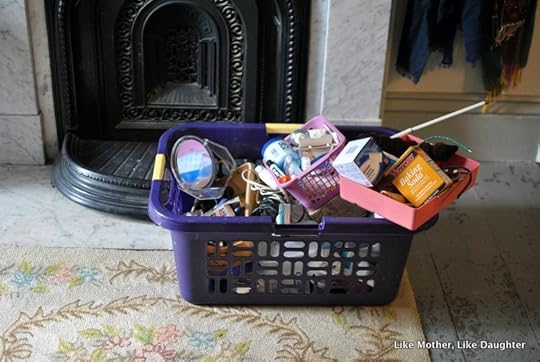
[image error] Loading InLinkz ...
The post {pretty, happy, funny, real} appeared first on Like Mother Like Daughter.
April 19, 2016
Chatty and knitty.
I think I have not shown you this shawl yet, other than a peek or two on Instagram (where the blue is not exactly as it looks in real life — here, the color is more accurately depicted and maybe a little gray for me).

I’m getting ready to go to Seattle for a weekend retreat where I will be speaking about Woman: Beloved, Blessed, and Beautiful: the woman’s vocation in God’s plan for the world.
This is how I get ready, with some built-in distractions: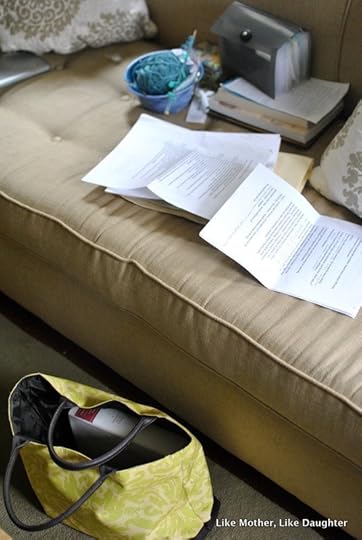
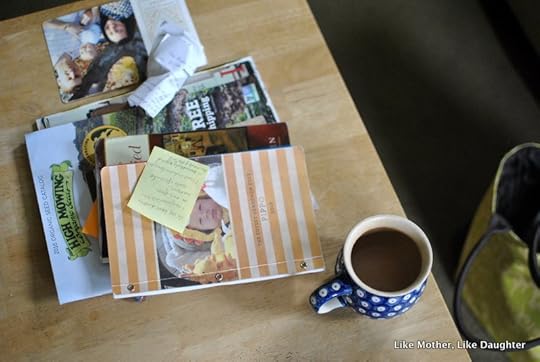
… and not counting doing laundry and quickly getting out some spring clothes, since up until quite recently we’ve still been bundling up… and also not counting trying to get the two bathrooms up and running (but not painted, because that just has to wait a little).
Renovations make me crazy (and perhaps pull me away from blogging a little), although of course they are a good thing. And a necessary thing. But it’s easy for me to somewhat despair of ever getting things back to normal, and also there’s an anxiety I have about all — all! — my choices that I find paralyzing, because construction seems so permanent.
I mean, it’s obviously not permanent permanent, but it is expensive and not really an actual possibility to change.
Decorating is easier for me. In the back of your mind you know you can always switch things up if you’ve made a mistake. When I say easier, I don’t mean that I do a ton of it! Who are these people who are constantly decorating and renovating — how do they have the energy, mental and physical? I have all the ideas and dreams… just not the energy!
But… now I’m thinking of a white laundry room/lavatory with a blue buffalo-check curtain…
Anyway, I did finish this shawl, and I will post details on Ravelry. The yarn is Frogtree Pediboo sock (it might be discontinued, but it’s very nice) and the pattern is Holden by Mindy Wilkes.



I’ve gotten better at keeping lace straight, so this wasn’t as hard as it was the last two times, although there are some tricksy parts having to do with the fact that you are mirroring in some places, so suddenly where it’s all in groups of five stitches, a “six” is thrown in, which doesn’t seem right. But it is. (Also can we be very proud of me that I didn’t run out of yarn??)
A while ago my dear son Joseph very kindly gave me this lovely ornament for my hair. I mean, I assumed it was for my hair — I don’t think either of us knew about shawl pins. But of course, I had and have quite short hair. I think that maybe he was remembering how my hair was when he was little — very long, actually.

I always felt bad that I really had no use for this lovely silver piece… until now! So thank you, Joseph!

What are you up to?
The post Chatty and knitty. appeared first on Like Mother Like Daughter.
April 16, 2016
{bits & pieces}
The weekly “little of this, little of that” feature at Like Mother, Like Daughter!
We are giving away one of our favorites, a copy of The Holy Gospels of St. Luke and St. John, to a lucky reader! Details on how to enter at the end of the post.
It’s now that season for First Holy Communions and Confirmations! Maybe you are that Godparent/Parent/Sponsor who just can’t think of what to give your little-saint-in-the-making as a gift on this important occasion.
Well, let me suggest that you give the brilliant The Holy Gospels of St. Luke and St. John.

The idea is simple, and you wonder why it hasn’t been done before.
You need a Gospel for your rapidly maturing young person that isn’t Bible stories, retold you know, rather than the actual words of Scripture; but you also need one that isn’t distracting, with study notes, verse numbers, and footnotes. All those are amazing in their place, but when you are praying with Holy Scripture, you just want to read and think and meditate on the actual words of the Bible.
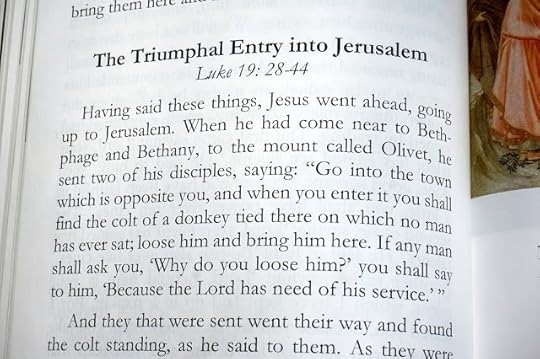
Illustrated with many beautiful works of sacred art from the past, this volume from the Sacred Art Series supplies the need. Yes, it’s good for children who can read, because the type is large and clear. And yes, pictures are helpful for kids, although I will say that it’s good for adults too. I use mine in my prayer. The artwork lets your mind rest and pray.

There’s a gold ribbon too, so you can keep your place.
Any child would benefit from this volume on a special occasion!*
This weeks links:
The guide to email signoffs. XOXO, vs. XX… Rosie sent that one, and it reminded me of one on Christian closings which I’ve had bookmarked all these years. The comments are also so funny (my fave: “Continuing in sin so grace might abound” haha)
Ever hear of a 16-year-old girl who rode twice as far as Paul Revere to call out the militia against the British in 1776? Perhaps Sybil Ludington should go on the $20 bill?
The Virgin Tomb in Scripture and theology.
Scientific Regress:
“The Whiggish view of scientific history is so dominant today that this possibility is spoken of only in hushed whispers, but ours is a world in which things once known can be lost and buried.”
Related: A rousing, hilarious, and fairly profane (that is: language alert! but then again, one of the most popular sites on Facebook and widely shared, is called I F***ing Love Science, which what the heck) essay on enablers of the scientific regress: Neil deGrasse Tyson: pedantry in space.
Not to open a can of worms, and maybe I will have to give this its own post, but a friend just sent me this post: A letter of Charlotte Mason to The New York Times on the subject of Maria Montessori’s methods, of which she does not approve. (You can find a pdf of the letter here by scrolling down a bit.) And although I find, along with Miss Mason it should be noted, some good qualities in her system, particularly (for me) the calming sense of order and the trust in the child’s seriousness in play, there has always been something which seems so artificial and needlessly complicated (not to say expensive) in her theory. Charlotte Mason explains exactly what this is.
From the archives:
The secret to planning menus (it’s maybe not quite what you think!)
Should my kids play sports?
Dating rules for teenagers in a crazy world.
To enter for the giveaway of The Holy Gospels of St. Luke and St. John, just leave a comment here! The giveaway will end Wednesday night.
~We’d like to be clear that, when we direct you to a site via one of our links, we’re not necessarily endorsing the whole site, but rather just referring you to the individual post in question (unless we state otherwise).~
Follow us on Twitter.
Like us on Facebook.
Auntie Leila’s Pinterest.
Rosie’s Pinterest.
Sukie’s Pinterest.
Deirdre’s Pinterest.
Habou’s Pinterest.
Bridget’s Pinterest.
Habou’s Blog: Corner Art Studio.
Auntie Leila’s Ravelry.
Auntie Leila’s Instagram.
Rosie’s Instagram.
Sukie’s Instagram.
Bridget’s Instagram.
*We have not received any compensation or consideration for this giveaway or review, as always. We provide it here for your benefit!
The post {bits & pieces} appeared first on Like Mother Like Daughter.
April 15, 2016
Joseph Ratzinger’s The Spirit of the Liturgy: A Book Club for Easter and Beyond

{Book Club: The Spirit of the Liturgy}
Let’s continue our reading, shall we, and move on to the next book?
We can take our time. No pressure.
If you are wondering whether this, of all books, is the one you should be spending your limited “reading energy” on, let me make a little pitch to you.
Maybe you’d like to tackle something meaty in your St. Gregory Pocket get-togethers — this would make a great couples’ discussion book.
And… you don’t want me to be just talking to myself, do you? Read along with me!
But, more seriously: it’s on your mind, isn’t it, how to teach your children to pray?
Well…
The crisis of our time is the question of what worship is. Having detached from the certainty of objective truth in the modern epoch, we find that it’s easy to think of worship as our feelings about God rather than an objective participation in worshiping God, apart from our preferences and circumstances.
Romano Guardini (whose book we studied during Lent, but of course you can start now if you like by following the links here) had one theme, which is that the Liturgy must be universal and grounded in Truth. Its chapters are ways of looking at that theme from different angles.
In this book, Joseph Ratzinger (who, of course, became Pope Benedict XVI) offers three considerations that will help us see the reality of worship —
history (what the Bible records about worship!)
man himself in his nature
and the cosmos (the actual created universe, including time).
Then he examines sacred art and music, which I think is where these somewhat abstract ideas intersect with the ordinary parish life of the ordinary Christian — namely, us and our children.
In his Preface (which is only a couple of pages — you can read it now), Ratzinger compares the Liturgy of Guardini’s time to a fresco, preserved from damage but whitewashed. Its true splendor was hidden by “instructions for and forms of private prayer” — that is, those devotions and rules that, while they can be good, tend to feed personal preference rather than universality. Worship needed rediscovery.
Perhaps at that point a restoration could have been accomplished, simply removing what obscured the prayer of the Church. However, things are never that easy, fallen man being who he is — the master complicator.
Not only was the liturgical movement sparked by Guardini not able to bring about that restoration, but in the ensuing years between him and our time, much more happened to endanger that “fresco.” Ratzinger speaks of possible “destruction” and “irreparable loss” — stark words that really strike fear in the heart of the believer, since if true worship perishes, so will we.
So, we need to scramble, to man our stations, to find “the right way of celebrating the liturgy, inwardly and outwardly.”
And, of immediate concern, I happen to think that we will do a much better job of transmitting our faith to our children if we know what our faith is. We desperately want them not only to believe but to worship. We consider ourselves failures (no matter how we try to console ourselves) if they do not.
And that means that we need to be clear on what it means to worship: in short, what is the spirit of the Liturgy?
**********************
I hope you will read along in this book club (or just read my posts, that’s okay): Joseph Ratzinger’s The Spirit of the Liturgy.*
Click here to see our previous discussion of Romano Guardini’s The Spirit of the Liturgy, which you can read free, online. You can also purchase it here, although be warned, this edition does not have the footnotes, which stinks
 .
.(When you buy something via our Amazon affiliate link, a little cash rolls our way… just a little. Thanks!)
I’ll post on Fridays, although for this longer book, perhaps not every Friday. I’ll give you your homework, I’ll talk about what we read, we’ll discuss in the comments. You can do this study at any point, but if you want to stay current and join in the convo, that’s how it will go.
Homework: Read the Preface and Chapter One of Part I. Know that Chapter One will make a lot more sense to you if you have read this chapter of Guardini, or at least this post.
There are twelve chapters, so I do anticipate this taking a nice long time. So worth it, though!
*I have permission from Fr. Fessio, the publisher, to quote from the book at will.
The post Joseph Ratzinger’s The Spirit of the Liturgy: A Book Club for Easter and Beyond appeared first on Like Mother Like Daughter.
April 14, 2016
{pretty, happy, funny, real}
What is this {pretty, happy, funny, real} you speak of?
~ {pretty, happy, funny, real} ~
Capturing the context of contentment in everyday life ~
Every Thursday, here at Like Mother, Like Daughter!
We’re enjoying our last Oklahoma spring. It’s amazing how green everything is right now, with the leaves mostly on the trees and the the storms starting to roll in and leave everything glowing behind.
Can we call this our kitchen garden? I think we’ll go with that. It sounds nicer than “That Bitty Bit of Dirt We Keep Talking About.”
The kids do spend a lot of time tending it. We’ve had one (tiny) salad from it so far, and just the other day planted the rest of the lettuce seeds in the empty spots left after overly attentive toddler gardening techniques prevented most of our peas and carrots from sprouting. (We have two of each in this box, and one brave snap pea plant that’s making a go of it way back behind the shed where I told the kids they could plant the rest of the seeds.)
(Can you tell that the front of the planter doesn’t get as much sun as the back? Not ideal for starting seeds, hm. Should’ve put in more soil.)
This little sweetheart turned one! We all agreed she would appreciate carrot cake for her birthday, and we weren’t wrong. (We made a little one-layer cake and a bunch of cupcakes so we could share with some friends with a new baby, just in case you picked up on the cake discrepancy there in the photos.)
We’ve been working on getting our house on the market, which means lots of cleaning, decluttering, organizing, and generally doing all sorts of things that we told ourselves we wouldn’t wait until we were moving to do, but did. That’s the way it goes, isn’t it?
I do now have approximately one million photos of my house looking sleek and svelte, and that’s something.
(Poor girl can’t figure out how to blow the seeds off a dandelion.)
We’ve got our first showings coming up, so it’s time now to perfect our laundry-basket-blitz-out-the-door routine, and put St. Joseph on the job to cover the rest.
[image error] Loading InLinkz ...
The post {pretty, happy, funny, real} appeared first on Like Mother Like Daughter.
April 13, 2016
Five secrets to staging and selling your reasonably clean home while homeschooling your large family
Sounds like a tall order, huh.
In fact, it seems impossible, and if you start to hyperventilate at the very thought of it, I don’t blame you. I’ve been there too, homeschooling five children (including two highschoolers) and nursing a baby. Rosie is getting ready to sell her house now*, and while she is super organized, her texts have reminded me that I have meant to give you my five secrets for getting this job done with some semblance of peace.

I mean, it’s not going to be peaceful.
The reason that people grow old and die in their inadequate and cluttered homes is that they can’t face the disruption of moving! But sometimes, face it you must. So here’s how.
We will take it as read that you have already googled the heck out of this topic.
You know that you have to declutter, and my Reasonably Clean House series is going to help you do that. Yes, you can KonMari everything. But chances are, if you are homeschooling and have lots of kids, that you need more stuff than the average millennial only now getting started on her family. You certainly have more books than Marie Kondo does, and that’s fine, as long as they are dusted and look pretty. Besides following all my thoughts on how to get a clean (reasonably so) house, there’s the issue of these strangers walking in. You can’t satisfy their standards, because you don’t know them, so the main thing to keep in mind is that whatever you have in your home should be clean and pretty. Make it pretty, especially the front door (“curb appeal”).
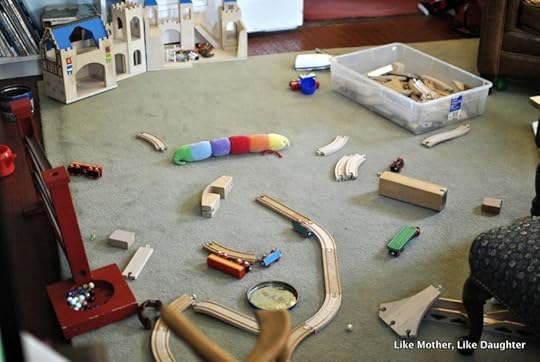

You already know that it has to all smell good. Now is the time to light that big scented candle you got for Christmas. Put it on your stove, where it won’t burn the house down.
You already know that your house has to be warm (if it’s cool out) or cool (if otherwise).
Now I am going to tell you how to achieve this when your house is not utterly fabulous and high end, your children are numerous, and your school must keep going regardless.
First secret: Start at the top and learn to blitz. (If you only have one level, start at the furthest point from the door you will ultimately exit.)
Selling your house is the fire under your behind to deep clean every zone in your house. But don’t do this the way you’d do it to please yourself… you must be able to declare an area “closed” in the sense of having been deep cleaned, and then later in the sense of “no one go in there.” (It’s not a bad idea to have no-go zones for the duration of the selling period if you can swing it.)
Once you have done that, you need to incentivize your children to perfect the blitz. Maybe show them The Hunt for Red October (if they are older) or take a field trip to the fire station and observe the drill. Once they see that their job needs military precision and a sense of urgency as for putting out a blaze, they will enter the spirit of the thing and execute.
In the blitz, just as with normal living, the goal isn’t to deep clean or even do the moderate clean. It’s just to make things tidy as quickly as possible so you can get out of the house and have it ready for showing. (You need the moderate clean for other days, though, so read up on it.)
The kids need to think this is a fun and exciting process that they do on the run. Besides some sort of model, they probably also need a bribe/reward waiting for them when they are done. You will end up in the car, so maybe stash some treats there or head for ice cream.

Second secret: Appearance of clean!
Unlike normal cleaning, you are not — repeat, NOT — going to clean in your normal fashion according to the areas that need it most or are most used. And you are not going to prioritize actual cleanliness (after you have done that necessary deep cleaning), but instead, the appearance of cleanliness.
Thus, pay more attention to wiping surfaces and vacuuming than to getting under the sofa cushions crumb free. Windows need to be sparkling more than sheets need to be laundered. (You can do the latter on a non-showing day.) It’s more important to get the toys off the lawn than to put your clutter away!
What?
Yes! Because…
Third secret: Laundry baskets!
You are not going to put your necessary clutter (as opposed to the unnecessary clutter that you got rid of before this whole process began) away!
You would go crazy!
You can’t do it!
No.
When you get the call to show the house, your drill will be that you initiate the blitz, throwing any “necessary” clutter that can’t immediately be put away in its proper place into laundry baskets as you exit the area.
You start to see the importance of starting at the top (or furthest portion) of your home and working your way down and out.
You must clean yourself out of your house.
The children need to go ahead of you, blitzing.
One child (or team) can be in charge of blitzing bathrooms (after you have carefully trained them in the art of making it look clean). One team can be in charge of making sure that beds are not only made but that any stray stuffed animals are propped up in front of pillows (which instantly makes the bed look charming rather than slovenly). One team wipes down stairs and removes any clutter from them.
Put any actual laundry in hampers or in the dryer. (Identify hiding places for things: Bins under beds, the space inside the dryer and inside the washer — but, don’t put things in the oven or stuffed in closets, because people look in there. They won’t open the fridge or deep freezer, though… )
If you are going to stay sane, you can’t have everyone running to and fro. No criss-crossing! No entering areas declared stranger-ready!
I developed this method when I realized that it was making me have a panic attack to have everyone running around randomly. My house had three floors and we started at the top (and in the bathrooms, because only so many people fit in one place) and backed our way out.
You are the last to leave a room while they are tackling the next part — and no one re-enters after you have left, just like in a fire drill! You are the last to leave a floor.
You give the floor (or zone) you are leaving the critical eye, snatching up personal things as you go, and then attend to the next one.
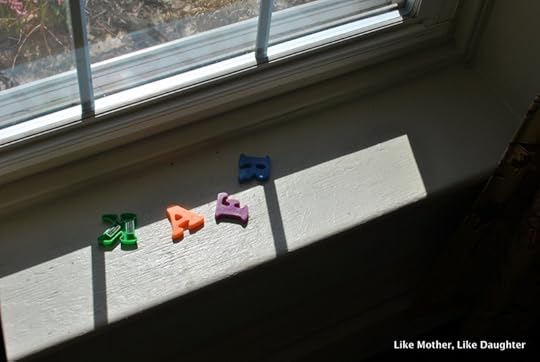
What do I mean by “necessary clutter”? What you can’t face putting away because you know that… you just can’t. So, everyone works their way out of the house, collecting toys, books, bath towels (and other bathroom detritus), sweaters, shoes, blankets, and other objects like random “personal knickknacks” as they go, in the laundry baskets (laundry bags and large trash bags are helpful too). Don’t waste time on putting every last thing away. Just toss it all in the basket.
Those get put in the back of the undoubtedly large vehicle you use to transport your brood (of course, when you first listed your home, you cleaned out the van too!).
Fourth secret: Homeschooling with backpacks.
Our high school kids kept the materials they were actually using in a backpack. They could just grab that. The younger ones can get their math books or whatever they are working on at the moment — they can use totes if that works better. And you can head for the library for the hour or two that it takes to show the house.**
Keep in mind two things:
One. If your children were at school, undoubtedly they would have days that schooling didn’t go as planned. At school there are drills and disruptions. It’s not as if every day every nose is on the grindstone — far from it. So if you use the showing time to run errands or visit a friend, that’s fine.
Two. Your house has certain basic qualities (or lack thereof) that make it marketable if the price is right. The biggest factor, actually, is what other houses recently sold for in your neighborhood. Realtors like to get you whipped up about how important your staging is, but the fact is that most people have decided when they pull up to the door whether or not they are interested. That your bathrooms and kitchen are functional is more important than whether you have teddy bears on the beds. That said, if it looks welcoming and tidy, it will appeal to them! So just work on that and don’t stress out!
Fifth secret, and the key to keeping the system running: Immediate homing of clutter upon return.

When you get home, take everything out of the car and put it, baskets and all, in the middle of the floor in a central place. Spend whatever time it takes to put each and every single item back in its place. Make your children your runners. What you will note immediately is that there are things that you resent having to cart in and out this way, and lo! these things can now easily be donated or discarded!
Thus, the clutter you are dealing with at any point is stuff you actually need right now — not accumulated flotsam and jetsam. You start to realize that you can function with much less than you thought. You also notice that this mode is effectively the “post-office system” — collecting things in a central location and then distributing (or discarding) them. It’s a good system even for the times you are not trying to sell your house.
Your children will develop a good eye for how things looked when you returned. If you play this period of your life well, you may just end up with higher standards all around!
*If you or anyone you know is moving to southwest Oklahoma and wants an adorable house, ping us!
**Your homeschool should be simple and streamlined anyway, but that’s a topic for another day.
The post Five secrets to staging and selling your reasonably clean home while homeschooling your large family appeared first on Like Mother Like Daughter.



